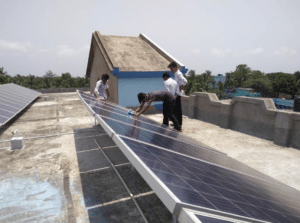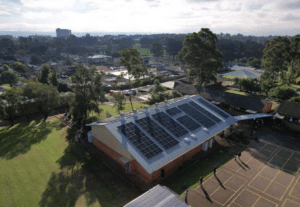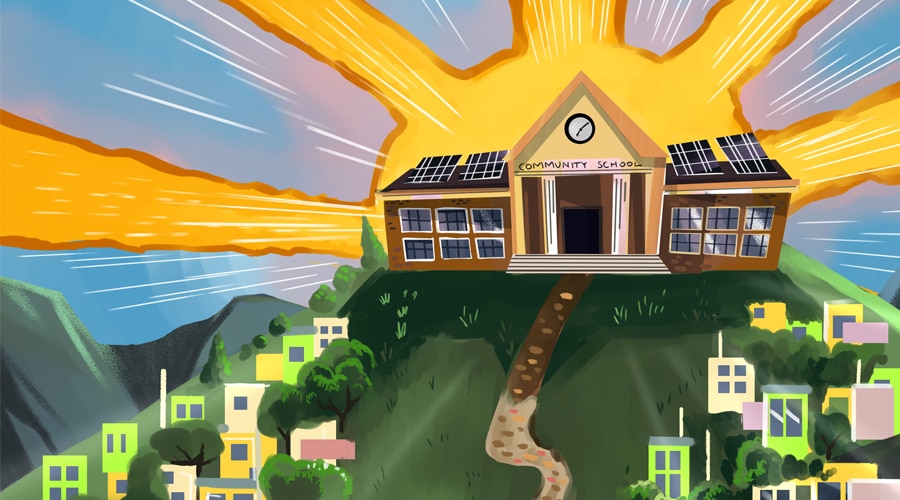America’s schools are making progress on the switch to clean energy. Since 2015, the amount of solar installed at K-12 schools has tripled and the number of schools with solar has doubled. Federal funds and incentives are making it even more affordable for schools to go solar to meet their energy needs while also gaining significant cost savings, STEM learning opportunities, and exposure to technology for workforce training.
However, schools going solar is not a trend limited to just the United States. Across the globe, governments and tax incentives help schools switch to clean energy to address their carbon emission goals, cut energy costs, enrich student learning, and enhance climate resiliency.
Take a journey around the globe and see how schools with state budgets and policies of all sorts are tapping into the benefits of solar.
Irish eyes – and schools – are smiling

Credit: C.B.S. Ennis Primary School, Ireland
Schools in Ireland are embracing solar power with remarkable success. All schools in Ireland will have an opportunity to receive free solar panels to help reduce their energy bills and cut carbon emissions over the coming 12 months. The move is part of a €50 million climate action scheme, first announced in the country’s 2022 budget.
C.B.S. Ennis Primary School became the first school in Ireland to produce all its electricity using solar power, setting an example for all schools to follow suit. The school not only slashed its energy bills by €10,000, but also demonstrated the feasibility and efficacy of clean energy in the education sector. As the Green Party continues to advocate for solar panel installations at every school, Ireland is poised to replicate this success story across the country.
Solar across the Americas
There’s more solar school momentum in North America beyond the United States. Canada is harnessing solar energy to power its educational institutions. The Municipal Climate Change Action Centre administers the Solar for Schools Program, successfully partnering with 50 schools in Alberta to help them switch to solar power, reduce greenhouse gas emissions, and inspire students to become agents of change – in the province that contains the largest tar sands deposits in the world.
In South America, a collaborative effort between the government of Mexico and Green Power Conferences is bringing solar power to rural schools. The ‘Iluescuelas’ initiative aims to deliver clean energy to nearly 30 schools in underserved communities that currently do not have access to electric power, transforming local infrastructure and expanding potential learning opportunities for students. States like Quintana Roo lead the way by converting schools to solar power through the initiative, with some schools even meeting 100% of their energy needs from solar, while fostering economic resilience and environmental stewardship for over 15,000 students.
Tea, scones, and solar in the UK
Britain’s 29,000 schools need up to £5.4 billion invested in efficiency upgrades and on-roof solar power generation if they are to achieve the government’s Net Zero targets. Academy Trusts (which are the UK’s version of school districts) are proving to be a formative part of the UK education sector’s response to climate change. Let’s Go Zero, the nationwide school campaign that supports schools to be zero carbon by 2030, has more than 2,300 schools from 389 Multi-Academy Trusts signed up to go solar.
Grant funding is a popular mechanism in the US to help fund the switch to solar power and it is an effective tool in the United Kingdom, too. A new program from the National Grid empowers under-resourced schools in South Wales, the South West, and the Midlands to switch to solar. Recipients of the grants so far expect to save more than £1 million (equivalent to $1.25 million) over the lifetime of their arrays. National Grid’s £2.7m grant will ultimately enable Solar for Schools to raise additional funding to enable about £10m worth of solar projects to happen – on schools that would otherwise not be able to go solar.
Estonia – a small but notable clean energy spark

Polva Gümnaasium, Estonia – Credit: Saint-Gobain
In the south-eastern corner of Estonia in the town of Põlva, a remarkable transformation is underway at the local high school. Polva Gümnaasium is proud of its flagship public high school, the first in the country with a near-zero carbon footprint. The project was primarily funded by the EU and includes rooftop solar, automated blinds that regulate temperature and lighting, and sustainably sourced wood and building materials.
The school also serves as a hub for sustainable living and community engagement. The project benefits more than just the 260 students and teachers. The school opens its doors to the local community for events and gatherings and fosters a sense of community and shared ownership for sustainable initiatives.
India goes solar at scale
Throughout India, many schools suffer from a lack of resources and struggle with fluctuating power reliability, particularly in the summers when the main grid gets overburdened. So far, seven percent of schools in India have already installed solar panels on their rooftops in the last five years to help address this challenge. This trend is expected to continue growing as government policies and incentives make it easier for schools to make the switch.

Akshaynagar Jnanadamoyee Vidyaniketan school in Kakdwip, West Bengal.
Credit: Thomson Reuters Foundation/Pranay Singh
One of the main drivers of this growth is West Bengal’s Sunshine Schools project, aimed at bringing cheap, reliable power to 25,000 remote public schools and adding 250 MW of clean energy to the grid. A high school in Bankura district said the school’s energy bills were 15,000-17,000 rupees every three months (equivalent to roughly $180). Solar has brought that down to nearly nothing. The school has used the savings for activities such as tree-planting, hiring teachers, and sanitation upkeep.
Private schools in India are also embracing solar energy. JH Tarapore School in Dhatkidih had installed solar long before the pandemic and the entire school is 100% powered by clean energy. They see a benefit not just in terms of cost-savings, but because it turns their students into responsible citizens: “Thanks to solar, the students will act as agents of change when it comes to educating their family and friends on clean energy,” said Lata Sharat, principal of JH Tarapore School.
Thanks to solar, the students will act as agents of change when it comes to educating their family and friends on clean energy.
Lata Sharat, Principal of JH Tarapore School in India
Down under, Australian schools advance solar

Kingswood Public School, Australia
The National Solar Schools Program (NSSP) was a Commonwealth Government initiative that provided grants of up to $50,000 for solar panels and other energy and water conservation measures. Although the NSSP has concluded, it left behind a legacy with over $217 million provided to 5,310 schools (60 percent of all Australian schools) to install renewable energy systems, rainwater tanks, and a range of energy efficiency measures.
To date, all Australian states and territories have some form of solar school program in place. In 2022, Queensland reached a major milestone with 200,000 solar panels installed at more than 900 schools across the state, as part of its $168 million Advancing Clean Energy Schools program. Victoria has a similar project in development providing upfront funding for solar installations, with over 232 schools currently taking part.
A global movement for the education sector to lead on climate action
There are many more countries with commitments or plans to invest in solar schools, from Japan to Turkey to Zimbabwe, a clear example of the solar contagion effect. When one household, school, school district, or country goes solar, others take note, learn from their example, and are more likely to do the same!
Let’s continue to support schools in the transition to solar so all students and global citizens can reap the educational, economic, and climate benefits of clean energy schools.















